
© Chuang Se-Lien
New Work for Comissioned Performer Submission NIME 07 / NYU New York
Andreas Weixler / Se-Lien Chuang
for Reynolds
audiovisual interactive improvisation
for violin and computer system

© Chuang Se-Lien
Todd
Reynolds, violin
Se-Lien Chuang, concept,
interactive visuals, Max/msp/Jitter
Andreas Weixler, concept, multi
channel granular synthesis, Max/msp/Jitter
1. Title of the work 3
2. Name (composer(s)/artist(s)) 3
3. Year of composition 3
4. Duration of performance 3
5. Description of the author(s) role, if any, in the performance 3
6. Narrative description of the work 4
7. Brief program note for inclusion in concert program / proceedings 5
8. Artist biographies 6
9. Set-up and rehearsal time required 8
10. Detailed technical requirements for the performer 8
11. Other technical requirements (sound, light,stage area, etc.) 8
12. Document of the technical set up (plans, drawing, sketch) 9
13. Images showing the work 11
14. Performer score or instructions 12
15. Links to additional audio-visual documentation 13
1. Title of the work
for Reynolds
2. Name (composer(s)/artist(s))
Andreas Weixler and Se-Lien Chuang
3. Year of composition
2007
4. Duration of performance
12 minutes
5. Description of the author(s) role, if any, in the
performance
The authors role in the performance acts as coperformer.
Andeas Weixler performes audio realtime processes of a multi channel
granular synthesis of the instrumental sound.
Se-Lien Chuang performs the interactive visuals processes controlled by
the sound of the live instrument.
The authors describe a computer-system programmed by the composers for
their audiovisual real-time performances.
It consists of an instrument played in the style of contemporary
composition. The computer system consists of a pitch and dynamic
detection, real-time visual processes and a live multi channel granular
synthesis with advanced controlling and performing methods. All
computing devices, the audio detection, the visual and the audio
processing are linked via a wireless LAN to reciprocally influence each
other
Andreas Weixler: multi channel
granular synthesis
by processing the instrumental sound in realtime the
computer becomes a hyper instrument played in an improvisation along
with the violin, spreading its sound on a 8 channel sound system,
controlling flocks of grains, rearranging those in terms of pitch,
time, order and position in the acoustic environment.
Melodic lines in horizontal time ordering will be replayed in a
vertical form of chords, which are determined by the original performed
notes as well as by individual pitch shifting of 4 indepentend granular
synthesis modules.
By its improvisation of music the data of the granular treatment also
determines parts of the visual computing, so the progression of music
and visuals appears in sync.
Se-Lien Chuang: interactive visuals
We developed a patch in Max
Jitter called ModularFilter. It either takes a live video
input, for example the performer, or some prepared pictures and movies
as a source of visuals. Sophisticated video effects will be exchanged
from part to part in the performance and their parameters are
controlled simultaneously by the sound of the instrument and the linked
parameter of the live granular synthesis as well.
6. Narrative description of the work
The sounds of live instruments serve as interface in
an audiovisual interactive concert that merges a sophisticated
instrumental sound and audiovisual real-time computing in an
improvisation. While visual images and processes are being generated
during the concert, a multi channel granular synthesis fits together
minute tonal particles that make up the instrumental sounds into a
constantly changing acoustic stream made up of different pitches,
duration and positions in the electro-acoustic space. The musical and
visual components interact and reciprocally influence each other in
order to blend into a unique, synaesthetic, improvisational work of
art.
The computer system and
Max/Msp/Jitter
created by Andreas Weixler and Se-Lien Chuang
two Macintosh G4 Powerbooks are interacting with the
players, i.e. of the violin and of the electroacoustic hyper
instrument, analyzing the sounds, exchanging data between analysis,
audio and video computing to make an age-old dream of artists come
true: to make music visible and images audible. The visual and musical
components interact and exercise mutual influence thus leading to
unique synthesis of arts.
The goal of this project in computer music is to create an interface
for visual and music computing for an associated audiovisual
composition as well as to find technical and artistic solutions for the
combination of traditional instruments with high technical computing in
the terms of interactivtiy and realtime processing and last but not
least to create pure computer music.
7. Brief program note for inclusion in concert program /
proceedings
Fragments of memories (produced both by human beings
and by computer) generate a synthesis of sounds and visuals. The sounds
of live instruments serve as interface in an audiovisually interactive
concert that merges a sophisticated instrumental sound and realtime
computing in an amazing improvisation.
While visual images and processes are being generated during the
concert, a multi channel granular synthesis fits together minute tonal
particles that make up the instrumental sounds into a constantly
changing acoustic stream made up of different pitches, durations and
positions in the electro-acoustic space. The musical and visual
components interact and reciprocally influence each other in order to
blend into a unique, synaesthetic, improvisational work of art.
with kind support of The Austrian Cultrual Forum in New York

8. Artist biographies
Andreas Weixler & Se-Lien Chuang
Andreas Weixler
born 1963 in Graz
Austria, Composer for contemporary instrumental composition, computer
music and media arts in audio visual interactivity.
education
study of composition and music theory at the
University of Music and Dramatic Arts in Graz, Austria. with Andrzej
Dobrowolski, Younghi Pagh-Paan, diploma with Beat Furrer 1995, master
of arts 1997 with Dr. Otto Kolleritsch, pre-studies in sound
engineering and physics.
specializing in computer music in workshops, studies, productions and
artist in residence in Austria, Germany, Swiss, England, France und
Japan 1993-2005
performances
composer, lecturer and media artist. Numerous international
projects of contemporary music, computer music, jazzrelated music, also
in cooperation with modern dance, contemporary theatre, video and fine
arts. Special emphasis in audio visual interactivity and algorithmic
composition, as well as electronic sound processing.
concerts, performances and lectures in Austria,
Germany, Swiss, France, Belgium, Netherlands, Italy, CSFR, Russia,
Canada, Columbia, Brasil, China, Taiwan, Japan, South Korea and USA.
broadcastings in Austria, Germany, Swiss, Netherlands, Hungary,
Finnland, Belgium a.o.
since 1981 running Atelier Avant Austria, Studio for contemporary
composition, computer music & media arts since 1996 together with
Se-Lien Chuang. http://avant.mur.at
teaching
since 2004 lecturer for interactive audiovisual projects / Max Msp
Jitter at the University of Arts in Linz, Institute of Media, interface
cultures
since 1997 lecturer at Bruckner-University Linz for music- & media
technology and computer music
Chuang Se-Lien
composer, pianist and media artist
1965 born in Taiwan, since 1991 residence in Austria
http://avant.mur.at/chuang
2003/04 lecturer in computer visual communication at
Tainan National College of the Arts, Department of Applied Music
/Taiwan;
2000/01 research project in computer music und
audio-visual arts in Nagoya City Universiy/Japan;
diverse performances and study-stays in Europe, Asia, Russia, Canada,
South- and North America.
training
2005 master of arts in composition (Beat Furrer) at the University for
Music and Dramatic Arts in Graz/Austria;
1999 diploma with distinction in Music and Media Technology at Studio
for Advanced Music and Media Technology (Adelhard Roidinger, Karlheinz
Essl) at Bruckner-University Linz/Austria;
scholarship in Silicon Graphics Studio at WIFI/ Graz/ Styria;
1996 piano-diploma in IGP - Instrumental-Vocal
Pedagogics (Walter Groppenberger) at the University of Music and
Dramatic Arts in Graz/Austria;
study of electro-acoustic music at the Institute of Electroacoustic and
Experimental Music (Tamas Ungvary, Wolfgang Musil) at the University of
Music and Dramatic Arts in Vienna/Austria;
artistic activities (selection)
portrait concert Weixler-Chuang - Experimental Intermedia NYC '06,
Goldsmiths College London/England '06; Wien Modern - Vienna/Austria
'05; ars electronica 2005, Linz/Austria; realtime/nonrealtime 2005,
Basel/Swiss; Ultraschall 2005 - Berlin/Germany; JSEM concert 2004 -
Japanese Society of Electronic Music, Tokyo/Japan; 2003 Busan
International Digital Technology Music Festival Busan/ South Korea;
SICMF 2002/03 -Seoul International Computer Music Festival Seoul/South
Korea; ISEA 2002 - the 11th International Symposium on Electronic Art
Nagoya/Japan; artport 2001 - MEDIASELECT 2001 Nagoya/Japan; Laval,
France _01; SIBGRAPI 2000 Video Festival/Gramado-RS, Brazil.
9. Set-up and rehearsal time required
1 hour set-up and rehearsal
During concert there will be an efficient change
10. Detailed technical requirements for the performer
description of electronics
The instrumentalist has microphones to input the instrumental sound in
our audiovisual computer system. The piece is an improvistaion between
contemporary instrumental sound, multi channel granularsythesis and
interactive visuals. Every one communicates even the computers do.
computer software
Max/MSP/Jitter
additional hardware
2 TFT VGA Monitor: 1 for display of multi channel
granular synthesis, 1 for display of interactive visulas
11. Other technical requirements (sound, light, stage area, etc.)
1 violin
4-8 channel audio system
2-4 subwoofer
4 monitor speaker (optional)
2 data projector
2 condensor microphones for violin
2 contact microphones for violin
1 mixing console on stage (4 line in, stereo out)
1 main mixer (4 mics in, 4 aux out, 4-8 line in, 4-8 out to main
speakers, 2 channel monitoring on 4 speakers)
1 DV Camcoder for visual input of violin
3 TFT VGA Monitor (2 for the violinist, 1 for the computer players)
2 desk ( one - width: about 160 cm, length: about 60 cm, hight: about
75 cm; another one - width: about 45 cm, length: about 55 cm, hight: as
high as grand piano)
2 black table-cloth for covering the desks (optional)
3 white light spots (1 for violinist, 2 for computer player), careful
not to disturb the projection !
dim blue lighting for stage area, not to disturb the projection
div. cables for the corresponding circumference
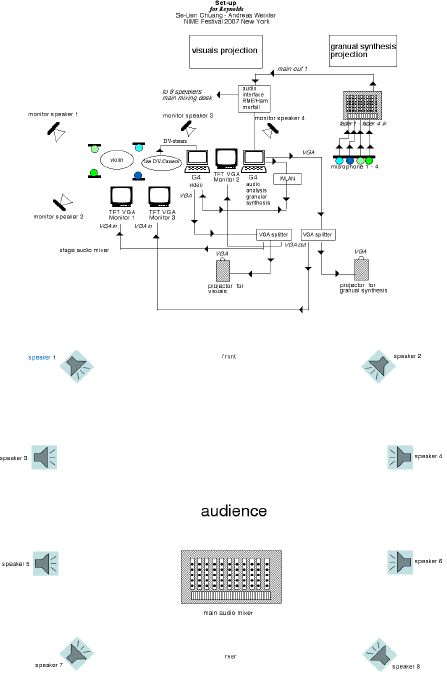
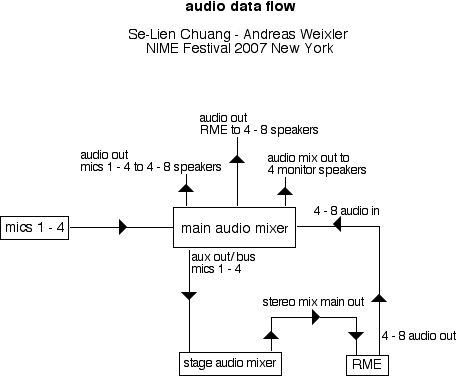
13. Images showing the work

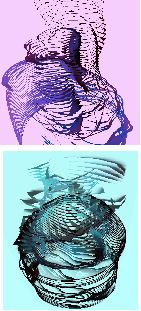
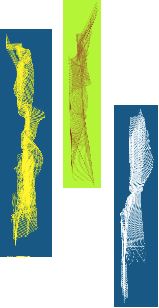
© Chuang Se-Lien
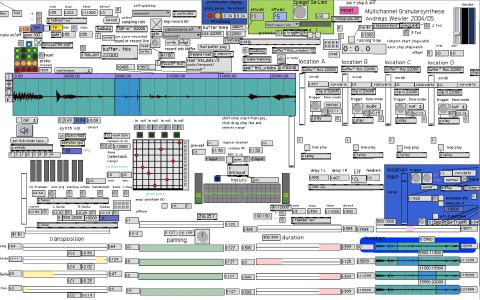
- # -